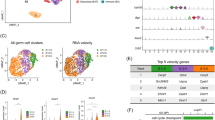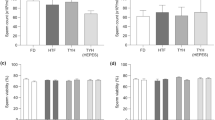Abstract
FERTILIZED mouse ova have been cultivated in vitro, and their development filmed, by Friedrich-Freksa and Kuhl1, who used as medium a clot of guinea pig plasma and mouse embryo extract containing segments of Fallopian tube2. Like Chang3, I have been working on ovum culture with a view to transplantation of ova. Chang has used rabbits, with serum as a culture medium ; I have chosen to use mice, as more readily available, and because (like most domestic animals) they have naked eggs. Seeking a medium readily prepared in large quantities, I have tried saline hen-egg extracts.
This is a preview of subscription content, access via your institution
Access options
Subscribe to this journal
Receive 51 print issues and online access
$199.00 per year
only $3.90 per issue
Buy this article
- Purchase on SpringerLink
- Instant access to full article PDF
Prices may be subject to local taxes which are calculated during checkout
Similar content being viewed by others
References
Kuhl, W., Abh. senckenberg. naturf. Ges., 456, 1 (1941).
Kuhl, W. (personal communication, 1947).
Chang, M. C., Nature, 159, 602 (1947).
Chang, M. C., Nature, 161, 978 (1948).
Author information
Authors and Affiliations
Rights and permissions
About this article
Cite this article
HAMMOND, J. Recovery and Culture of Tubal Mouse Ova. Nature 163, 28–29 (1949). https://doi.org/10.1038/163028b0
Issue date:
DOI: https://doi.org/10.1038/163028b0
This article is cited by
-
Influence of the storage conditions of embryo culture media on mouse development
In Vitro Cellular & Developmental Biology - Animal (2024)
-
A 3D “sandwich” co-culture system with vascular niche supports mouse embryo development from E3.5 to E7.5 in vitro
Stem Cell Research & Therapy (2023)
-
The in vitro culture of mammalian embryos
Nature Methods (2023)
-
Mouse embryo assay for human in vitro fertilization quality control: a fresh look
Journal of Assisted Reproduction and Genetics (2020)
-
Deconstructing and reconstructing the mouse and human early embryo
Nature Cell Biology (2018)



